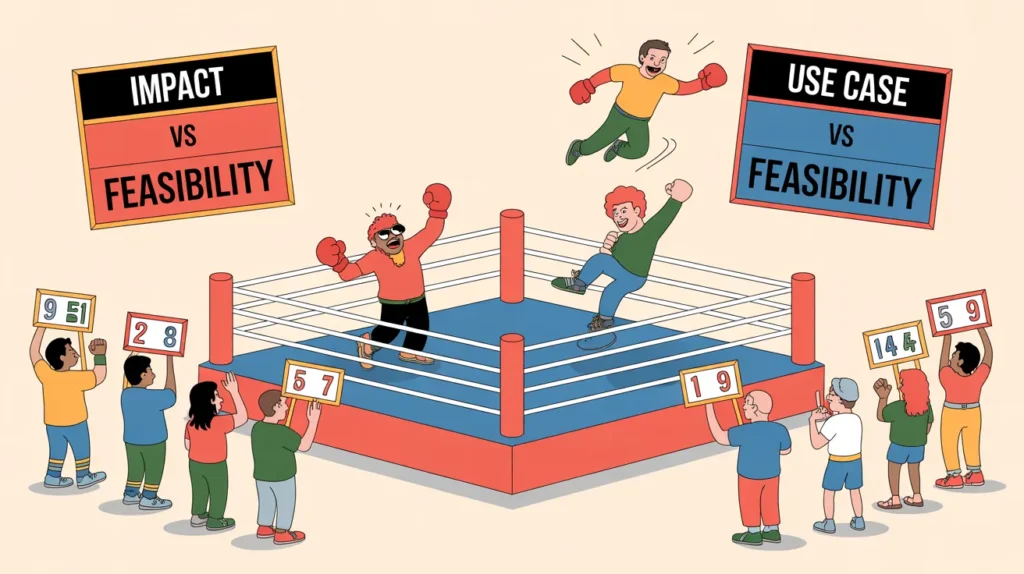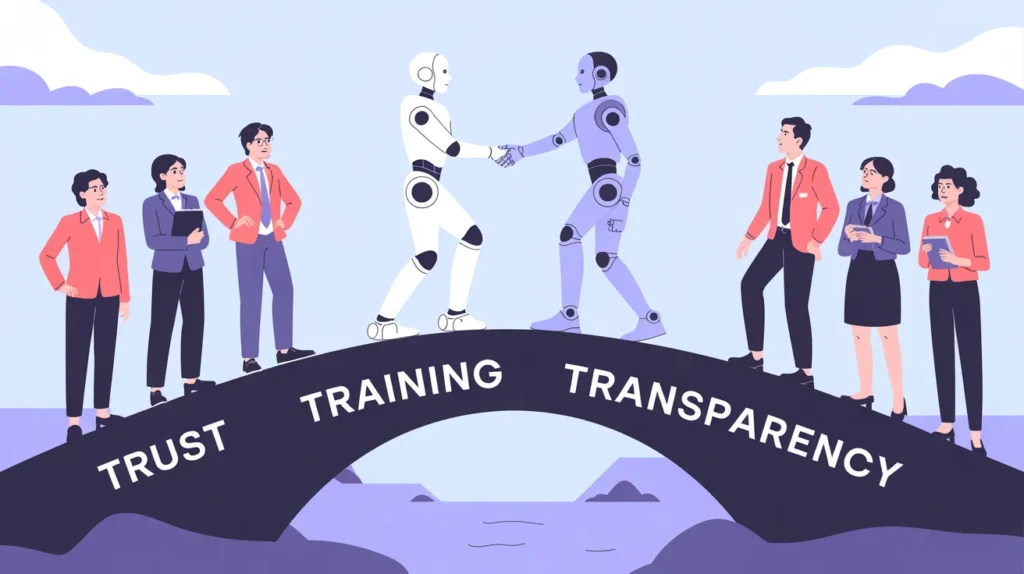Imagine unlocking the full power of AI in your business—not with complicated coding or jargon, but through clear decisions and practical teamwork. Today, artificial intelligence is no longer just a futuristic trend or buzzword; it’s becoming a real driver of growth, efficiency, and smarter decision-making. And if you think that you don’t need AI to run your business, think again, because you are going to miss out on what AI can do, plus you are risking your business by not developing it for the future.
But the challenge is not knowing where to start, and how to put AI to work in a way that delivers value to your business. Many leaders feel overwhelmed, assuming AI is for tech experts alone. But the truth is, with the right roadmap, any forward-thinking leader can guide their organization through a successful AI implementation.
If you want your business to be future-ready and competitive, the time to act is now. Let’s break AI implementation down into simple, actionable steps—so you can move from questions to real results, one smart decision at a time.
The 8-Step AI Implementation Roadmap
AI projects struggle when they’re treated as exotic IT experiments. IBM’s 8-step success checklist bluntly warns that “AI without a business owner is like a self-driving car without a destination”. Translation: leadership sets the route; data scientists hold the steering wheel. I agree with the 8 steps that IBM discovered. Let’s dive into it
Step 1: Discovery – Understanding Your Business Foundation
Let’s cut to the chase. Your business has problems that are costing you time, money, or sanity. Maybe all three. The key to successful AI implementation isn’t jumping straight to flashy solutions—it’s identifying which problems actually matter.

Start With Your Top 3 Business Headaches
Grab a coffee and think about what makes you want to pull your hair out on a weekly basis:
- Late deliveries that have customers calling every hour
- Customers are disappearing faster than you can replace them
- Paperwork mountains that require three people just to stay afloat
- Manual processes are eating up hours of productive time
Don’t assume you know the real problem. A logistics company spent months perfecting its delivery routes, convinced that was its biggest issue. Turns out, customers were actually frustrated because nobody told them when packages would arrive. One simple communication fix solved what they thought was a complex routing problem.
Try the “Whine & Win” Exercise
Here’s a practical approach that works: Set aside one hour with your team. Split it into two parts:
First 30 minutes – The Whining Session: Let everyone complain about their daily frustrations. No solutions allowed—just honest venting about what slows them down.
Second 30 minutes – The Winning Session: Look at each complaint and ask: “What would happen if we could automate this or predict it?” Vote on which fixes would create the biggest impact.
What You’re Really Looking For
The goal isn’t to list every minor annoyance. Focus on problems that:
- Happen repeatedly (not one-off issues)
- Costs you real money or time
- Affect your customers directly
- Currently requires manual work that could be automated
Once you’ve identified your top pain points, you’ll have a clear target for AI solutions that actually matter to your business. No fancy tech for the sake of it—just practical fixes for real problems.
What business headaches are keeping you up at night? Comment Down Below !!
Step 2: Use Case Selection – Prioritizing for Quick Wins and Long-Term Value
Now that you’ve identified your business pain points, it’s time to separate the game-changers from the time-wasters. Not every problem deserves an AI solution, and not every AI solution is worth pursuing right now.

The Two-Round Fight: Every Idea Must Survive Both
Think of this like a boxing match. Each potential AI use case needs to win on two fronts:
Round 1: Impact – Does This Actually Matter?
Ask yourself: “If we solved this problem completely, would anyone notice on the bottom line?”
Look for problems that directly affect metrics you already track:
- Revenue drivers: Customer acquisition, retention, average order value
- Cost reducers: Labor hours, material waste, processing time
- Risk minimizers: Compliance failures, security breaches, quality issues
If solving the problem won’t move a needle you measure monthly, it’s probably not worth the investment.
Round 2: Feasibility – Can We Actually Pull This Off?
Even the most impactful idea is worthless if you can’t execute it. Be brutally honest about:
- Data availability: Do you have enough quality data to train an AI system?
- Budget reality: Can you afford the technology, integration, and ongoing maintenance?
- Stakeholder support: Will the people who need to use this actually embrace it?
- Technical complexity: Is this a manageable first step or a moonshot project?
The Simple Scoring System That Works
RTS Labs has the right approach here. Grab a whiteboard and score each use case from 1-5 on both dimensions:
Impact Scale:
- 1 = Nice to have
- 3 = Noticeable improvement
- 5 = Game-changing difference
Feasibility Scale:
- 1 = Nearly impossible with current resources
- 3 = Challenging but doable
- 5 = We could start this next month
Plot It Out and Find Your Quick Wins
Draw a simple grid with Impact on one axis and Feasibility on the other. Plot each use case as a dot. The magic happens in the top-right quadrant—high impact, high feasibility. These are your quick wins.

Quick wins (High Impact + High Feasibility): Start here. Build momentum and prove AI can work in your business.
Strategic projects (High Impact + Low Feasibility): Put these on your roadmap for later, once you’ve built AI capabilities.
Easy experiments (Low Impact + High Feasibility): Good for learning, but don’t expect business transformation.
Avoid entirely (Low Impact + Low Feasibility): No explanation needed.
Make It a Team Sport
Don’t do this scoring exercise alone in your office. Get the people who understand the problems (operations) and the people who understand the constraints (IT, finance) in the same room. The best insights come from honest debate about what’s really possible and what really matters.
The goal isn’t to find the perfect AI project—it’s to find the right first AI project that builds confidence and delivers results.
What problems are landing in your quick-win quadrant?
Step 3: Data Audit – Assessing Your Digital Foundation
Here’s the uncomfortable truth: Your AI project will only be as good as your data. And if your data is scattered across dozens of spreadsheets with names like “Customer_List_FINAL_v12_USE_THIS_ONE,” you’re setting yourself up for expensive failure.

Before you get excited about machine learning algorithms, you need to take a hard look at your digital foundation. Think of this as a pre-flight inspection—boring but absolutely critical.
The Harsh Reality of Bad Data
Poor data quality kills 27% of AI projects before they even reach the pilot stage. That’s not a technology problem—it’s a data problem that expensive AI tools can’t fix. Garbage in, garbage out isn’t just a saying; it’s a costly business reality.
The Four Pillars: Your Data Health Checkup
Ask yourself these questions honestly. If you’re wincing at the answers, you know where to focus your efforts.
1. Quality – Can You Trust What You Have?
- When was this data last verified for accuracy?
- How many duplicate customer records exist in your system?
- Are there obvious errors, missing fields, or outdated information?
- Do different departments have conflicting data about the same customers or products?
Red flag: If your sales and customer service teams argue about basic customer information, your data quality needs work.
2. Accessibility – Can People Actually Get to the Data?
- How long does it take someone to pull a simple report?
- Do you need to email three different people to get complete information?
- Are teams still copying data between systems manually?
- Can you combine data from different departments without a major IT project?
Red flag: If generating a monthly report requires “heroic efforts” from your team, accessibility is your problem.
3. Security – Is Your Data Protected and Compliant?
- Who has access to sensitive customer information?
- Are you meeting industry compliance requirements (GDPR, HIPAA, etc.)?
- Is data encrypted both in storage and when moving between systems?
- Do you have audit trails showing who accessed what data when?
Red flag: If you can’t quickly answer “who can see our customer financial data,” security needs immediate attention.
4. Governance – Does Everyone Know the Rules?
- Who’s responsible for data accuracy in each department?
- Are there clear policies about data collection, storage, and usage?
- How do you handle data conflicts between different systems?
- Is there a process for updating or correcting information?
Red flag: If different departments define “active customer” differently, governance is your issue.
Start Your Audit: The 48-Hour Challenge
Don’t overthink this. Pick one critical business process and trace the data journey:
- Day 1: Follow a single customer record from initial contact through final sale
- Day 2: Try to generate a simple report combining data from three different systems
Note every pain point, manual step, and “workaround” you discover. This exercise will reveal your biggest data obstacles faster than any consultant report.
You don’t need perfect data to start with AI, but you need data that’s good enough to produce reliable results. If your current data situation makes you nervous, invest in cleaning it up before investing in AI technology.
Remember: AI amplifies whatever you feed it. Feed it messy data, get messy results. Feed it clean, accessible, secure data with clear governance, and you’re setting the foundation for AI success.
What does your current data situation tell you about your AI readiness?
Step 4: Skills and Talent Audit – Building Your AI-Ready Team
Forget the myth that you need a team of PhD data scientists. Your existing team probably has more AI potential than you realize. The key is honest assessment and smart gap-filling.

Map What You Already Have
Start by auditing your current team’s strengths and identifying realistic skill gaps:
| Role | Current Strength | Gap to Fill |
| Business Analyst | Deep process knowledge | Basic ML literacy |
| IT Lead | Integration expertise | Cloud AI services familiarity |
| Project Manager | Change management savvy | Data-driven KPI mindset |
| Operations Manager | Workflow optimization | Automation tool knowledge |
| Finance Lead | Budget and ROI tracking | AI project cost modeling |
The Smart Strategy: Upskill vs. Partner
Upskill internally when gaps feel manageable—think online courses, workshops, or vendor training sessions.
Partner externally when gaps feel like the Grand Canyon—specialized consultants, AI vendors, or temporary contractors.
The Winning Formula
McKinsey research shows that blended teams consistently outperform both pure vendor solutions and pure in-house efforts. Your domain experts know the business problems; external specialists know the AI solutions. Together, they create implementations that actually work.
Your business analyst understands why customers churn better than any consultant ever will. An AI specialist knows how to build predictive models. Combine them, and you get churn prediction that actually reflects your business reality.
Start Small, Build Smart
Don’t try to build an AI dream team overnight. Start with your current people, identify the biggest skill gap for your first project, and fill just that gap. Success will build confidence and justify further investment in capabilities.
The goal isn’t to become an AI company—it’s to become a company that uses AI effectively.
What skills does your team already have that could support your first AI project?
Related Post: The AI Blueprint: 4 Pillars Every Future-Ready Business Needs
Step 5: Vendor and Partner Selection – Choosing the Right Technology Partners
Every AI vendor claims they’re revolutionary. Most are just expensive. With thousands of platforms promising to transform your business, you need a simple way to separate real solutions from shiny marketing presentations.
The V.E.T. Test: Your BS Detector
Before you get dazzled by demos, put every AI platform through these three filters:
V – Value Proof: Show Me Real Results
Skip the glossy demos with perfect fake data. Demand evidence that actually matters:
- Real customer testimonials from companies similar to yours
- Specific metrics showing ROI, time savings, or cost reductions
- Case studies with actual numbers, not vague “improved efficiency” claims
- References you can actually call and ask tough questions
Red flag: If they can’t show you measurable results from real customers, keep looking.
E – Ethics Stance: Transparency Matters
AI systems make decisions that affect your business and customers. You need to understand how:
- Data usage: Where does your data go? How is it stored and protected?
- Model bias: How do they test for and address unfair outcomes?
- Certifications: Do they meet industry standards (SOC 2, ISO 27001, etc.)?
- Explainability: Can the system tell you why it made specific recommendations?
Red flag: If they’re vague about data handling or can’t explain their bias mitigation, that’s a hard pass.
T – Technical Fit: Integration Reality Check
The fanciest AI is worthless if it doesn’t work with your existing systems:
- Current stack compatibility: Does it connect with your CRM, ERP, or database?
- Implementation complexity: Are you looking at months of integration work?
- Support requirements: Do you need new infrastructure or specialized IT skills?
- Data format flexibility: Can it work with your existing data structure?
Red flag: Any vendor pushing “rip and replace” solutions probably doesn’t understand your business reality.
The Hidden Cost Trap
IBM’s research highlights a critical point: integration costs often exceed the software license fees. Before you sign anything, get clear answers about:
- Configuration and setup fees
- Data migration costs
- Training and onboarding expenses
- Ongoing maintenance requirements
- Support and update pricing
Make Vendors Prove It
Don’t take their word for anything. Ask for:
- Pilot programs with your actual data
- Free trials that go beyond basic demos
- Detailed cost breakdowns, including all hidden fees
- References from customers who’ve been using the system for at least a year
The best AI platform isn’t the one with the most features—it’s the one that solves your specific problem, fits your budget, integrates smoothly, and comes from a vendor you can trust.
Remember: You’re not buying AI technology. You’re buying a solution to a business problem that happens to use AI.
Which part of the V.E.T. test do most vendors in your space struggle with?
Related Post: Is Your AI Worth It? How to Track AI ROI with Real-World Examples
Step 6 – Pilot & Rollout: Start Small, Learn Fast
Think of your pilot as a controlled experiment, not a make-or-break launch. This is where you learn what works, what doesn’t, and what surprises await—all without risking your entire operation.

Set Clear Boundaries: The Three Must-Defines
Scope: Keep It Narrow and Manageable
Don’t try to solve world hunger on your first attempt. Pick something specific:
- One location: Single branch, warehouse, or department
- One process: Customer onboarding, inventory forecasting, or quality control
- One timeframe: One month of transactions, one product category, or one customer segment
Example: Instead of “improve customer service,” try “reduce response time for billing inquiries in the northeast region.”
Timeline: 8-12 Weeks Is the Sweet Spot
Long enough to see meaningful patterns, short enough to maintain focus and momentum:
- Weeks 1-2: Setup and data integration
- Weeks 3-8: Active testing and learning
- Weeks 9-12: Analysis and decision making
Any longer and you risk scope creep. Any shorter and you won’t gather enough data to make informed decisions.
Feedback Loop: Weekly Reality Checks
Set up regular check-ins to catch problems early:
- Weekly stand-ups with all stakeholders
- Real-time monitoring of key metrics
- Quick adjustments when something isn’t working
- Document everything – wins, failures, and surprises
Real Success Looks Boring
A grocery chain didn’t revolutionize retail—they just tested AI demand forecasting for fresh produce in ten stores. Nothing glamorous about predicting banana sales, but the results spoke volumes: 14% reduction in food waste.
Because it worked, they carefully expanded to 300 stores over six months. No dramatic transformations, no emergency implementations—just steady, measured growth based on proven results.
What Success Actually Looks Like
Your pilot succeeds when you can confidently answer:
- Does this solve the problem we identified?
- Are the results worth the investment?
- Can we scale this without breaking other things?
- Do people actually want to use this system?
Pilot Red Flags to Watch For
Stop and reassess if you see:
- Declining user adoption after the initial novelty wears off
- Results that look good on paper but don’t translate to real business impact
- Constant technical problems that require heroic IT efforts
- Stakeholder resistance that isn’t improving with training
A successful pilot isn’t about perfect AI performance—it’s about proving you can implement, measure, and improve an AI solution within your actual business constraints.
The best pilots feel almost mundane. They solve a specific problem, deliver measurable results, and create confidence for bigger projects. No cape required.
What narrow, specific problem could serve as your ideal pilot testing ground?
Step 7 – Change Management: The Human Side of the Algorithm
People hate change—except the kind jingling in their pockets.” Your AI project’s success depends less on the technology and more on whether people actually use it.

The Three T’s: IBM’s Proven Formula
1. Transparency – Kill the Black Box Fear
People resist what they don’t understand. Make AI less mysterious:
- Explain the “why”: How does this make their job easier or better?
- Show the “how”: What data does the system use? How does it make decisions?
- Be honest about limitations: What can’t the AI do? When should humans override it?
Example: Don’t just say “the system recommends this customer.” Say “based on their purchase history and recent inquiries, the system suggests they’re likely to buy within 30 days.”
2. Training – Make It Hands-On and Human
Skip the boring PowerPoints. People learn by doing:
- Interactive workshops with real scenarios they’ll face
- Video walkthroughs they can reference later
- Peer buddy system pairing tech-savvy employees with hesitant ones
- Just-in-time help is available when they’re actually using the system
3. Trust-Building – Celebrate Teamwork, Not Replacement
Show how AI makes humans more valuable, not obsolete:
- Share early wins that demonstrate clear benefits
- Highlight human expertise that AI enhances rather than replaces
- Celebrate success stories where human judgment plus AI insight created better outcomes
Reframe the Narrative
When a chatbot cuts call time by 30%, don’t celebrate the efficiency gain. Celebrate that customer service agents can now handle complex cases that actually advance their careers and provide better customer experiences.
Wrong message: “AI makes us faster.” Right message: “AI handles the routine stuff so you can focus on the interesting challenges.”
Change management isn’t a one-time event—it’s an ongoing process. Expect resistance, plan for setbacks, and keep reinforcing the benefits until AI adoption becomes routine.
Remember: The most sophisticated AI system is worthless if your team won’t use it.
How will you help your team see AI as a teammate rather than a threat?
Step 8 – Success Metrics & Continuous Improvement: Measure, Tweak, Repeat
You can’t manage what you don’t measure. Set your success metrics before you flip the AI switch, or you’ll be scrambling to justify results after the fact.

Define Success Upfront: Key Metrics That Matter
Choose metrics that directly connect to business outcomes people actually care about:
Operational Efficiency
- Cost reduction per transaction: How much does AI save on each customer interaction or process?
- Time-to-decision: How much faster can teams make critical choices with AI insights?
- Process completion rates: What percentage of tasks now happen without human intervention?
Customer Impact
- Net Promoter Score uplift: Are customers happier with AI-enhanced service?
- Response time improvement: How much faster do customers get answers or solutions?
- Customer retention changes: Are people staying longer or leaving faster?
Business Intelligence
- Forecast accuracy delta: How much more accurate are your predictions with AI?
- Error rate reduction: What percentage of mistakes has AI eliminated?
- Revenue impact: Can you trace specific dollars back to AI-driven decisions?
Make Skeptics into Believers
Nothing converts AI doubters faster than a live dashboard showing real savings accumulating in real time. When your CFO can see exactly how much money AI saved this month, budget conversations get much easier.
Before launch: “This AI thing seems expensive and risky.” After seeing the numbers: “How quickly can we expand this to other departments?”
The Quarterly Reality Check
Your metrics aren’t set in stone. Plan to revisit and adjust them every three months because:
- AI models drift: Performance changes as they encounter new data patterns
- Business priorities shift: What mattered in Q1 might be irrelevant by Q4
- You learn what actually matters: Some metrics prove more valuable than others
Pro tip: Don’t just track AI performance—track adoption rates. The best AI system is worthless if people aren’t using it consistently.
Keep It Simple and Visible
Choose 3-5 key metrics maximum. Too many numbers create confusion; too few miss important insights. Display them somewhere everyone can see them, update them regularly, and celebrate when they move in the right direction.
The goal isn’t perfect measurement—it’s clear evidence that AI is delivering the business value you promised.
What specific number would make your biggest AI skeptic into a believer?
Engaging Stakeholders Early (and Often)
- Executives: Speak in ROI, not tensors.
- Operations: Invite them to prototype reviews—nothing builds buy-in like seeing their ideas live.
- Finance: Share transparent cost assumptions from day one.
- HR: Align upskilling plans with performance goals.
- Legal & Compliance: Loop them in whenever data usage or privacy changes.
A ScienceDirect paper on stakeholder roles shows multi-department projects are 2.4× more likely to hit adoption targets. Collaboration isn’t fluffy—it’s predictive.
Common Barriers—and How to Solve Them

Barrier 1: Lack of a Clear Strategy
Problem: Organizations often dive into AI initiatives without establishing clear objectives or understanding how these technologies align with their business goals. This shotgun approach leads to scattered efforts, wasted resources, and disappointing results that fail to deliver meaningful value.
Solution: Begin with comprehensive business-first discovery sessions to identify specific pain points and opportunities where AI can create a genuine impact. Prioritize use cases based on feasibility, potential ROI, and strategic importance. Develop a roadmap that connects AI initiatives directly to measurable business outcomes, ensuring every project has clear success metrics and stakeholder buy-in from the outset.
Barrier 2: Skills and Talent Gaps
Problem: Many companies assume they need to hire expensive teams of data scientists and AI specialists before they can begin their AI journey. This misconception creates budget constraints and delays implementation while organizations search for scarce technical talent.
Solution: Implement strategic upskilling programs for existing employees, focusing on AI literacy and practical application skills. Forge smart partnerships with AI vendors, consultants, and technology providers who can bridge capability gaps while internal teams develop expertise. Consider hybrid approaches that combine in-house talent development with external partnerships to accelerate learning and implementation.
Barrier 3: Organizational Resistance
Problem: Employee fear of job displacement and resistance to change creates internal barriers that can sabotage even well-planned AI initiatives. This resistance often stems from a lack of understanding about AI’s role as an augmentation tool rather than a replacement.
Solution: Establish transparent communication channels that clearly explain AI’s purpose and benefits. Involve employees in the implementation process through inclusive change management practices. Demonstrate how AI enhances rather than replaces human capabilities, and provide concrete examples of how team members’ roles will evolve and improve with AI support.
Barrier 4: Data Quality Issues
Problem: Poor data foundation—including incomplete, inconsistent, or inaccurate data—severely undermines AI effectiveness. Many organizations discover too late that their data infrastructure cannot support sophisticated AI applications, leading to unreliable outputs and failed projects.
Solution: Conduct systematic data audits to identify quality issues, gaps, and inconsistencies across all relevant data sources. Implement comprehensive cleanup processes that standardize formats, eliminate duplicates, and establish ongoing data governance protocols. Invest in data infrastructure improvements that ensure consistent, high-quality data flows to support current and future AI initiatives.
Barrier 5: Unrealistic Expectations
Problem: Organizations often expect immediate, transformational results from AI implementations, leading to disappointment when projects require time to mature and deliver value. This impatience can result in premature project abandonment and loss of stakeholder confidence.
Solution: Set realistic timelines that account for the iterative nature of AI development and deployment. Break large initiatives into smaller, manageable phases with clear milestones. Celebrate incremental wins and communicate progress regularly to maintain momentum and stakeholder engagement throughout the implementation journey.
Putting It All Together
AI Implementation takes planning. First, you figure out what you want to solve. Then you pick the best problems to start with. You check if your data is good enough and if your team has the right skills. You find good partners to help you. You test small projects first. You help your team accept the changes. And you track if it’s actually working.

Here’s a real example: A furniture company had too many broken products being shipped to customers. They didn’t know much about technology, but they knew returns were costing them money. They used cameras and AI to spot defects on their production line. After eight months, they had 19% fewer defective products. Even better, the factory managers who didn’t trust the technology at first became big supporters of using AI in other areas.
Ready to Roll?
Use this plan at your next team meeting. Give everyone sticky notes and start planning together. Remember, the goal isn’t to show off that you use AI. The goal is to let AI work quietly in the background while your business gets the credit for better results.
It’s time to start your AI journey. Take the first step and begin planning how AI can help your business succeed.







Pingback: AI Is Seriously Transforming These Business Areas—Are You Missing Out?